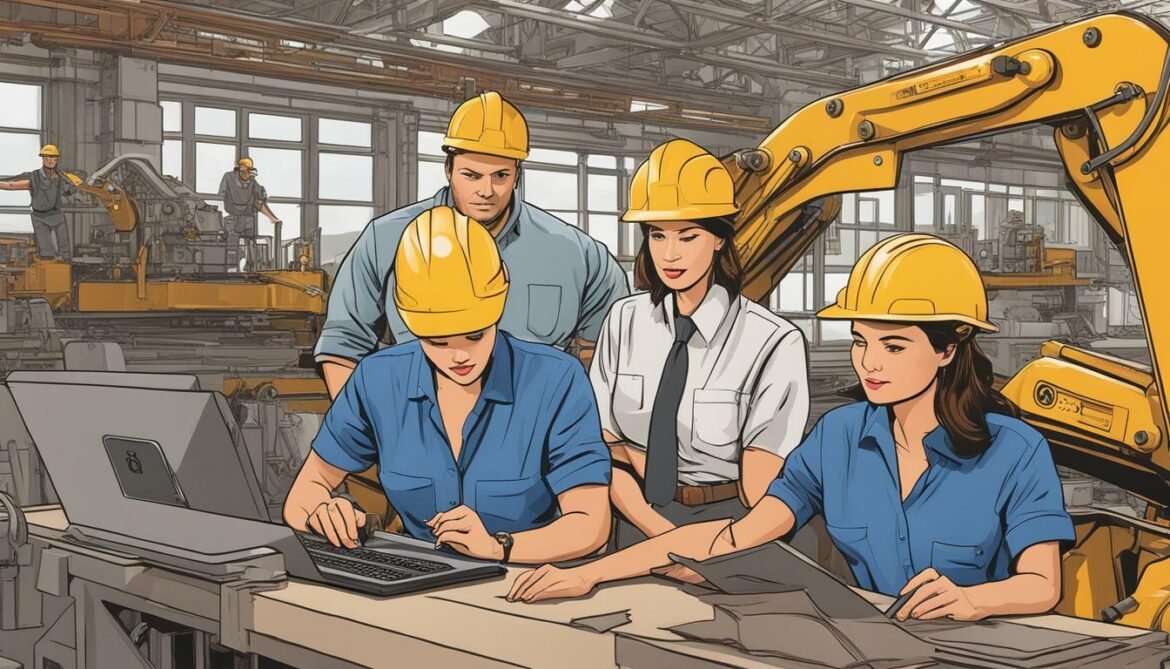Closing the Gender Gap: Strategies for Encouraging Women in Engineering
Engineering has traditionally been a male-dominated profession, with women significantly underrepresented in the industry. However, the importance of gender diversity in STEM fields is becoming increasingly recognized, and efforts are being made to encourage more women to pursue careers in engineering.
Encouraging women in engineering is not only a matter of gender equality but also of improving business performance. A diverse engineering workforce can lead to increased innovation, problem-solving abilities, and overall success in the industry.
However, breaking down gender stereotypes and addressing barriers and biases is crucial in achieving gender diversity in engineering. Supportive environments, mentorship programs, and educational outreach initiatives are necessary to empower female engineers and promote gender equality in the industry.
Key Takeaways:
- Encouraging women in engineering is important for both gender equality and business performance.
- A diverse engineering workforce can lead to increased innovation and problem-solving abilities.
- Breaking down gender stereotypes and addressing barriers and biases is crucial in achieving gender diversity in engineering.
- Supportive environments, mentorship programs, and educational outreach initiatives are necessary to empower female engineers and promote gender equality in the industry.
Understanding the Benefits of a Diverse Engineering Workforce
A diverse engineering workforce has numerous benefits, including increased innovation, problem-solving abilities, and improved business performance. It also provides a unique opportunity to bring together people from different backgrounds, experiences, and perspectives. In this section, we will explore the advantages of a diverse engineering team, focusing on the benefits of empowering female engineers.
Innovation and Problem-Solving
When teams are composed of individuals with different backgrounds, experiences, and perspectives, they bring diverse ideas and solutions to the table. This leads to increased innovation and creative problem-solving, as team members are more likely to challenge assumptions and look at problems from multiple angles. In the engineering industry, this can result in the development of more effective and efficient processes, technologies, and products.
“Diverse teams are more innovative and make better decisions 87% of the time.” – Harvard Business Review
Improved Business Performance
A diverse workforce has been shown to improve business performance. Studies have found that companies with diverse executive teams are more profitable and have higher revenues than those with homogenous teams. Additionally, companies with more women on their boards have been found to have higher Return on Equity (ROE) and Return on Sales (ROS) than companies with fewer women on their boards.
“Companies in the top quartile for gender or racial and ethnic diversity are more likely to have financial returns above their national industry medians.” – McKinsey & Company
Unique Perspectives and Skills of Female Engineers
Women bring unique perspectives and skills to the engineering industry. According to research, women tend to have a high level of emotional intelligence, which can be beneficial in team settings. They also bring a different perspective to design and problem-solving, which can lead to more innovative and effective solutions. Additionally, women tend to have strong communication and collaboration skills, which are essential in a team environment.

“Diversity is not just a buzzword, but a key ingredient to creating a successful and innovative business. Empowering female engineers is not only the right thing to do, but it also makes good business sense.”
By creating a more diverse engineering industry, we can unlock the full potential of our talent pool and create a more innovative and effective field. In the next section, we will explore strategies for breaking down gender stereotypes and promoting diversity in engineering.
Breaking Gender Stereotypes in Engineering
Despite progress towards gender equality, stereotypes and biases continue to discourage women from pursuing engineering careers. Society often views engineering as a male-dominated field, with women being perceived as less competent or unfit for the job. To address this issue, breaking down gender stereotypes is crucial to encourage women in engineering and promote diversity in the field.
“Without women, engineering is simply incomplete.”
Studies show that gender diversity in the workplace leads to increased innovation and better problem-solving. Empowering female engineers to bring their unique perspectives and skills to the table enhances creativity and can improve business performance. One way to promote diversity is to address the root of the issue.

“The various stereotypes surrounding engineering were often discouraging, and it was easy to feel like an outsider in the classroom. But staying true to my passions allowed me to break barriers and exceed expectations in the field.” – Mary Jackson, American Aerospace Engineer, and Mathematician
Breaking down gender stereotypes requires challenging societal norms and promoting positive female role models in STEM fields. By highlighting the successes of women in engineering, it helps to inspire and empower future generations to pursue the field. Successful initiatives and programs, such as Girls Who Code, have helped to promote women in STEM careers by providing educational resources and mentorship opportunities.
However, promoting diversity in engineering is not just about encouraging more women to enter the field but also creating supportive environments for them to thrive. Mentorship programs, networking opportunities, and workplace policies that promote gender equality are essential in supporting the advancement of women in engineering. These efforts can help to bridge the gender gap in the engineering field and empower female engineers to succeed.
Creating Supportive Environments for Women in Engineering
Creating supportive environments for women in engineering is crucial for promoting gender equality in the industry. Advocacy for women in engineering is necessary to ensure they have equal opportunities for career advancement and professional development. Mentorship programs, networking opportunities, and workplace policies can all contribute to creating a supportive work environment.
Mentorship programs are an excellent way to provide guidance and support for female engineers. These programs pair women with experienced colleagues who can offer advice and guidance on navigating the industry. Mentors can also help women build their professional networks and connect them with relevant resources.
Networking opportunities are also important for women in engineering. These events provide a platform for women to connect with other professionals in the industry and learn about career opportunities. Networking events can also help women build their confidence and develop important skills such as communication and leadership.
Workplace policies are critical for promoting gender equality in engineering. Companies can adopt policies such as flexible work arrangements, equal pay for equal work, and family-friendly benefits that support women in their careers. These policies can help address barriers such as the gender pay gap and unconscious bias in the workplace.

Image source: seowriting.ai
Overcoming Barriers and Addressing Bias
Despite progress towards gender equality in the engineering industry, women still face various barriers and biases that prevent them from fully participating in the field. Raising awareness and addressing these issues is essential in bridging the gender gap in engineering.
Unconscious Bias in Hiring and Promotion
One of the barriers that women face in the engineering industry is unconscious bias. This refers to the implicit attitudes or stereotypes that people hold about certain groups, which can influence their decisions and actions. Unconscious bias can manifest in the hiring and promotion process, with women being overlooked for positions or promotions due to assumptions about their abilities or commitments outside of work.
To address this issue, organisations can implement policies and training programs to raise awareness and reduce the impact of unconscious bias. This could include unconscious bias training for recruiters and managers, as well as the use of blind screening processes where personal details such as gender, ethnicity, or age are removed from resumes.
Gender Pay Gap
Another barrier that women face in the engineering industry is the gender pay gap. According to a report by the Institution of Engineering and Technology, the pay gap in engineering is around 9%, with women earning less than their male counterparts in equivalent roles. This gap may be due to a range of factors, including unconscious bias, lack of negotiation skills, and differences in career progression and opportunities.
To address the gender pay gap in engineering, organisations can conduct regular pay reviews to ensure that there is no gender bias in salaries and benefits. Additionally, companies can implement transparent promotion and career development processes that allow for equal opportunities for all employees regardless of gender.
Underrepresentation in Leadership Positions
Women are also underrepresented in leadership positions in the engineering industry. According to the Women’s Engineering Society, women make up only 12% of the engineering workforce in the UK and only 8% of engineering managers. This lack of representation can make it difficult for women to progress in their careers and can perpetuate the gender gap in the industry.
To address this issue, organisations can implement targeted initiatives and programs to promote women into leadership positions. This could include mentoring programs and leadership development opportunities, as well as setting diversity targets and holding managers accountable for achieving them.
Image of Engineers
The image of engineers as being masculine and male-dominated can also discourage women from pursuing engineering careers. To address this issue, it is important to challenge these stereotypes and promote positive female role models in STEM fields.

“We need to change the perception of engineering from that of ‘dirty work’ to one that is exciting, creative, and innovative. Promoting more diverse role models in the industry can help to encourage a wider range of people, including women, to pursue careers in engineering.”
– Jane Sutton, Director of Engineering at Rolls-Royce
By promoting diverse role models, organisations can help to challenge gender stereotypes and inspire more women to pursue engineering careers.
Encouraging Girls in STEM Education
Encouraging girls to pursue STEM education is crucial in breaking down gender stereotypes and promoting diversity in the engineering industry. Research shows that girls are just as interested in STEM subjects as boys, but they often lack the confidence and support to pursue these fields.
To encourage girls in STEM education, targeted outreach programs and resources should be made available to inspire and empower them. Mentoring can play a critical role in helping girls overcome barriers and build confidence in pursuing STEM careers. Programs such as Girls Who Code and TechGirlz provide opportunities for girls to learn coding and programming skills, connect with female role models in STEM fields, and explore career possibilities.
| Program | Description |
|---|---|
| Girls Who Code | A non-profit organization that aims to close the gender gap in technology by teaching girls to code and providing them with mentorship and support. |
| TechGirlz | A non-profit organization that offers free workshops, summer camps, and other programs to encourage middle school girls to explore technology and STEM fields. |
It is also important to provide girls with positive female role models in STEM fields. By seeing successful women in these industries, they can develop a sense of belonging and see themselves as a part of the industry. Initiatives such as Million Women Mentors and Women in Science and Engineering provide networking and mentorship opportunities for women in STEM fields and work to inspire the next generation of female engineers.

By promoting STEM education for girls and providing them with the support and resources they need to succeed, we can create a more diverse and inclusive engineering industry. This will lead to increased innovation, problem-solving abilities, and better business performance.
Conclusion
Encouraging women in engineering is essential for promoting gender equality and diversity in technology. As we have highlighted throughout this article, a diverse engineering workforce has numerous benefits, including increased innovation and problem-solving abilities, as well as improved business performance.
To achieve gender equality in engineering, we must break down gender stereotypes and promote positive female role models in STEM fields. Creating supportive environments that prioritize mentorship, networking, and workplace policies that support the advancement of women in engineering is also crucial.
Overcoming barriers and addressing bias in the engineering industry is no easy feat, but it is essential for bridging the gender gap and empowering female engineers. We must continue to raise awareness around unconscious bias and take action to address barriers such as gender pay gaps and lack of representation in leadership positions.
Continued Action is Required
Encouraging girls in STEM education is also key for promoting diversity in engineering and inspiring the next generation of female engineers. Targeted outreach programs, educational resources and mentorship opportunities are essential for empowering young girls to pursue engineering and other STEM fields.
It is imperative that we continue these efforts to close the gender gap and create a more inclusive engineering industry. Together, we can promote gender equality and diversity in technology and create a brighter and more innovative future for all.
FAQ
Q: What is the importance of encouraging women in engineering?
A: Encouraging women in engineering is important for promoting gender equality and diversity in the industry. It helps to close the gender gap and ensures that different perspectives and skills are represented in the field.
Q: What are the benefits of a diverse engineering workforce?
A: A diverse engineering workforce brings increased innovation, problem-solving abilities, and improved business performance. Gender diversity in particular allows for unique perspectives and skills that women can contribute to the industry.
Q: How can we break gender stereotypes in engineering?
A: Breaking gender stereotypes in engineering involves challenging societal norms, promoting positive female role models in STEM fields, and implementing initiatives and programs that support and promote women in STEM careers.
Q: What can be done to create supportive environments for women in engineering?
A: Creating supportive environments for women in engineering involves implementing mentorship programs, providing networking opportunities, and establishing workplace policies that promote gender equality and support the advancement of women in the industry.
Q: How can barriers and bias be addressed in the engineering field?
A: Addressing barriers and bias in the engineering field requires awareness and education around unconscious bias, as well as initiatives to overcome barriers such as gender pay gaps and lack of representation in leadership positions.
Q: Why is it important to encourage girls in STEM education?
A: Encouraging girls in STEM education is crucial for promoting diversity in engineering and other STEM fields. By providing targeted outreach programs, educational resources, and mentorship opportunities, we can inspire and empower young girls to pursue engineering careers.
Q: What is the conclusion of the article?
A: The conclusion of the article emphasizes the importance of encouraging women in engineering, promoting gender equality and diversity in the industry. It highlights the benefits of a diverse engineering workforce and calls for continued efforts to close the gender gap and create a more inclusive industry.








